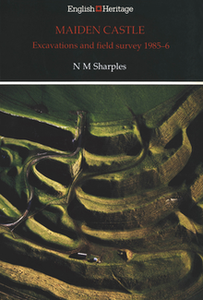English Heritage Archaeological Monographs
English Heritage, 2014. https://doi.org/10.5284/1028203. How to cite using this DOI
Data copyright © English Heritage unless otherwise stated
This work is licensed under the ADS Terms of Use and Access.
Primary contact
Historic England
The Engine House
Firefly Avenue
Swindon
SN2 2EH
Resource identifiers
- ADS Collection: 1416
- DOI:https://doi.org/10.5284/1028203
- How to cite using this DOI
Maiden Castle: Excavations and field survey 1985-6
Sharples, N.
English Heritage (1991)
Abstract:

This report discusses the results of a programme of research in 1985 and 1986 into the history of the hillfort of Maiden Castle as part of a wider, continuing programme of work concerned with the improved management of the monument. This involved three studies aimed at understanding the detailed history of human activity: a survey of the setting of the monument, detailed geophysical and ground survey of the earthworks and interior, and selective excavation. The large quantities of artefactual and environmental material which were recovered are described and placed within this history of occupation. Activity on the hilltop ranged from the construction of a double ditched enclosure, a Bank Barrow, and other Neolithic occupation, through a period of comparative inactivity, to the period of hillfort building and occupation in the Iron Age. The occupation of the hillfort went through a period of sustained development from loosely structured agglomerations of houses to regularly laid out 'streets'. There was some occupation of the hilltop after the Roman Conquest, and a temple was later constructed within the abandoned hillfort. After the abandonment of the temple, the principal function of the hilltop became that of pasture for the lowlying settlements in the valleys of the Frome and South Winterborne and has remained so until the present day.
Download monograph
| Maiden Castle: Excavations and field survey 1985-6, Sharples, N., English Heritage (1991), ISBN: 9781848021679 | 84 Mb |





